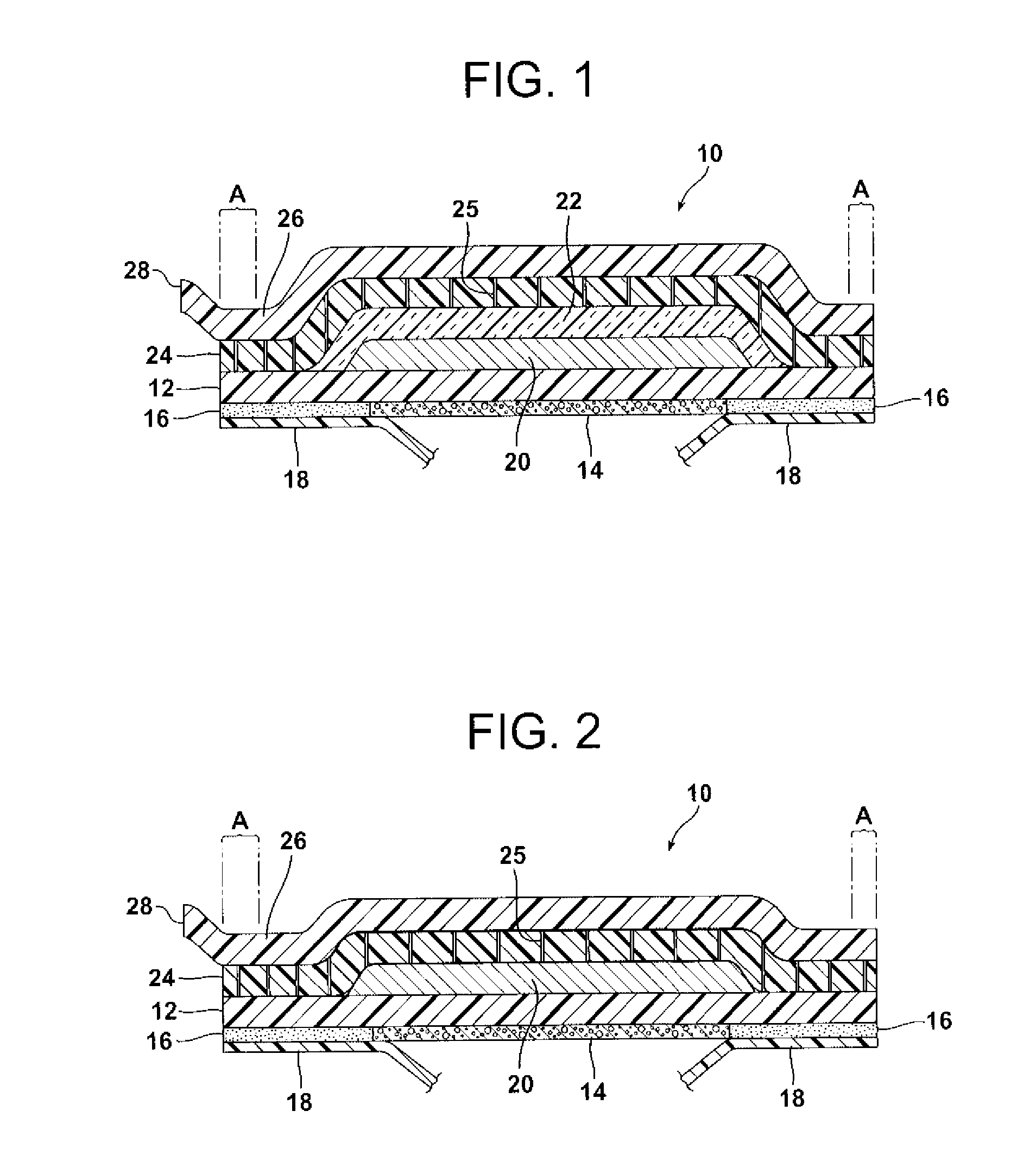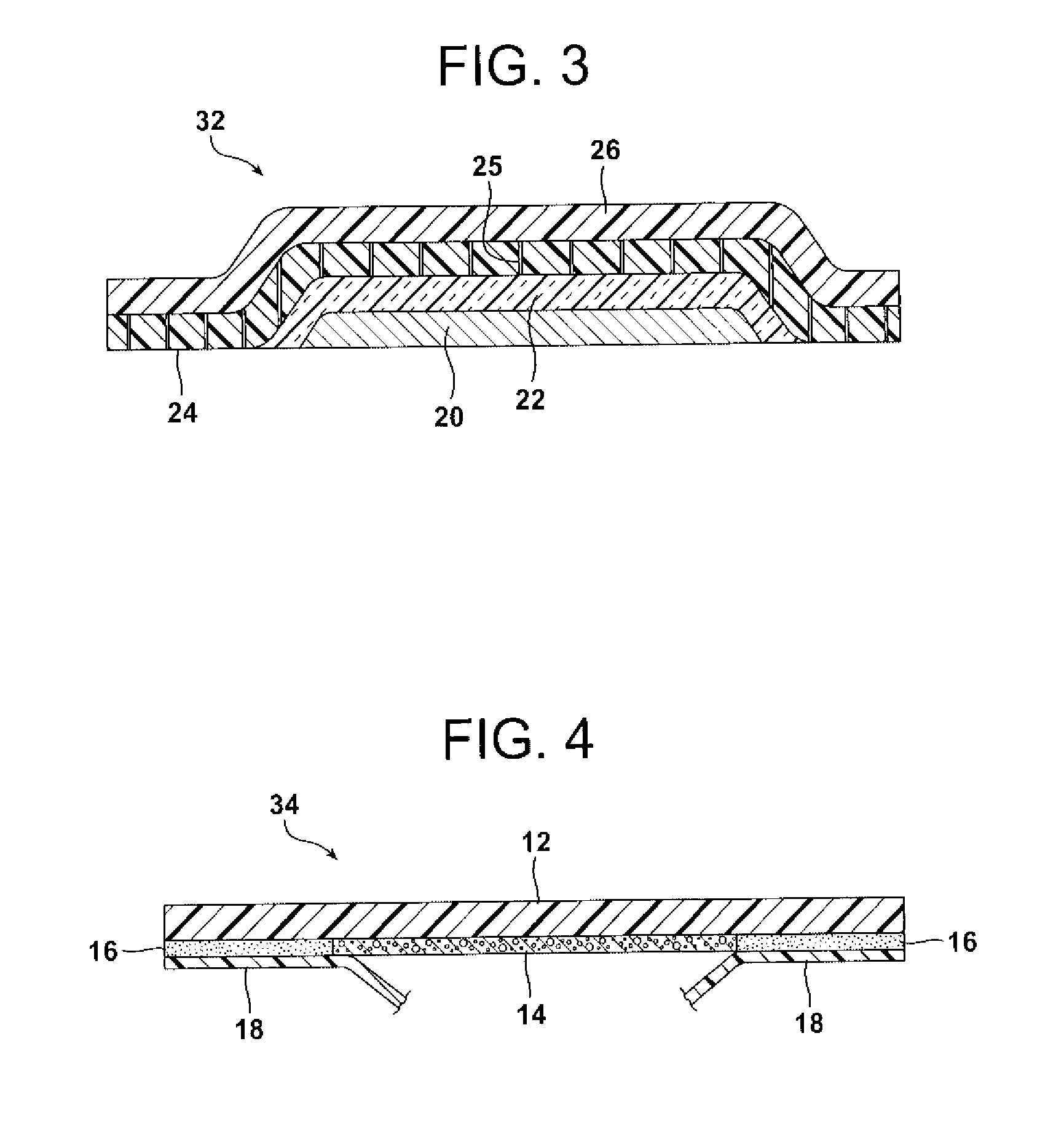Self-Heating Patch
a self-heating patch and patch technology, applied in the field of self-heating patches, can solve the problems of difficult control, light skin patches, difficult to use as relatively thin,
- Summary
- Abstract
- Description
- Claims
- Application Information
AI Technical Summary
Benefits of technology
Problems solved by technology
Method used
Image
Examples
example 1
[0209]A Gurley Densitometer, Model 4150N equipped with a 4320 Automatic Digital Timer, was used to characterize the relative permeation rate of film samples. Pressure was 6.52 psi, sample area was 1 sq. in., and displacement volume was 10 cc. This test method measures the time for a known air volume to pass through a porous film sample under a known air pressure gradient. A longer time value thus indicates a lower permeation rate.
[0210]Table 4 below shows the results obtained:
TABLE 4Air permeation measurements on film samplesFilm SampleGurley ReadingDesignationFilm Sample Description(seconds + / − std. dev.)1FS-1, as made22.4 + / − 0.52FS-1, after heating @22.7 + / − 0.2140° F. for 1 minute3FS-1, after heating @65.8 + / − 0.5275° F. for 1-2 minutes4FS-1, after heating @245 + / − 3 275° F. for 1-2 minutes, then @282° F. for 1-2 minutes5FS-2, as made42.3 + / − 4.16FS-2, after heating @994 (single reading)140° F. for 1 minute7FS-3, as made 51.4 + / − 13.18FS-4, as made122 + / − 16
[0211]The results of ...
example 2
[0213]An Omega Model HH309A four-channel data logger thermometer was used for collection of time-temperature measurements from the surface of test patches constructed using Sample FS-1 to Sample FS-4 films, as described below.
[0214]The general procedure for making test patches was to affix a piece of 3″ wide clear packaging tape to the face of a flat rectangular metal frame having a 2″×6″ opening and made from ⅛″ aluminum. Inside a nitrogen-filled glove box, an approximately 1″×2″ test strip of self-heating material was removed from a COOKPAK heater. This sheet, about 1 / 16″ thick, was affixed to the tape surface centered inside the metal frame so as to leave at least ½″ open margin around all sides. One or two microporous film samples was / were laid over this heating material, waxed side up (where applicable) so as to extend at least ½″ beyond the self-heating material edges. The film sample was press-adhered to the tape surface so as to form a seal around all edges. In some cases a ...
example 3
Prophetic Example
[0220]A perimeter-sealed self heating patch is constructed from a self heating layer, a top film layer and a bottom film layer, where the self heating layer does not extend to the edges and is sealed between the top and bottom film layers, which come into contact around the edges.
[0221]The layers are defined further as follows:
[0222]Top Film Layer
[0223]A continuous microporous flexible film having average pore size of less than 10 microns, e.g. less than 1 micron, and an air permeation rate that leads to a time of less than about 2000 seconds, and greater than about 200 seconds, when the film is tested in a Gurley tester at 6.52 psi, 10 cc displacement, 1 sq. inch area.
[0224]In one embodiment, this film is made from a heat-treated composite microporous film having core layer and skin layers, where the core layer has a lower melting temperature range than the skin layers and the heat treatment is within the melting temperature range of the core layer. In another embo...
PUM
| Property | Measurement | Unit |
|---|---|---|
| Temperature | aaaaa | aaaaa |
| Flexibility | aaaaa | aaaaa |
| Adhesivity | aaaaa | aaaaa |
Abstract
Description
Claims
Application Information
 Login to View More
Login to View More - R&D
- Intellectual Property
- Life Sciences
- Materials
- Tech Scout
- Unparalleled Data Quality
- Higher Quality Content
- 60% Fewer Hallucinations
Browse by: Latest US Patents, China's latest patents, Technical Efficacy Thesaurus, Application Domain, Technology Topic, Popular Technical Reports.
© 2025 PatSnap. All rights reserved.Legal|Privacy policy|Modern Slavery Act Transparency Statement|Sitemap|About US| Contact US: help@patsnap.com



